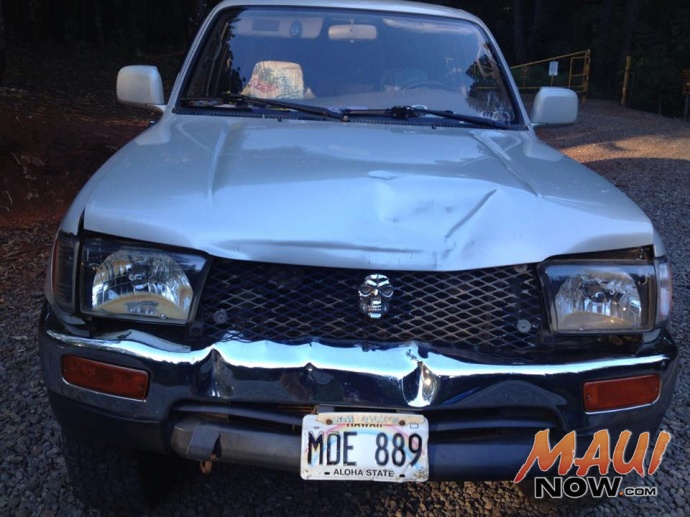Capobianco Trial: Surveillance of 4Runner, Zip Ties, Stained Jeans Recovered

Honomanū, Nuaʻailua Bay, Photos by Wendy Osher.
By Wendy Osher
Surveillance video of a 4Runner headed up Baldwin Avenue in Pāʻia, was one of the items presented as evidence in court on Wednesday in the ongoing murder trial of Steven Capobianco.
Maui police officer Jeffrey Calibuso said he made checks of businesses along Baldwin Avenue and Hāna Highway to see if any of them had surveillance footage of Capobianco’s vehicle on the morning of Feb. 9, 2014.
The vehicle was supposed to be stalled in East Maui according to what the defendant had told police during an earlier interview, when he had said the vehicle got stuck about three miles past Keʻanae on Feb. 8, 2014.
He had told police that he hitchhiked back so he could get to work in the morning, and that Carly “Charli” Scott picked him up on Sunday evening, Feb. 9, 2014, so that he could retrieve his vehicle. Scott, who was Capobianco’s ex-girlfriend, was reported missing the next night after she failed to show up for work and did not return phone calls and messages from her family members.
Capobianco is standing trial for Scott’s murder, and for setting her vehicle on fire. Scott was 27-years-old and five months pregnant at the time with an unborn child fathered by the defendant. Capobianco has pleaded not guilty to the charges.
4Runner Seen on Surveillance in Pāʻia
Officer Calibuso said footage was captured of a 1990s model Silver Toyota 4Runner, traveling up Baldwin Avenue at 6:41 a.m. on Sunday, Feb. 9, 2014.
Police had asked mangers at the Bank of Hawaiʻi Pāʻia branch for footage from their ATM surveillance camera for the period between 6:15 and 9:30 a.m. on Sunday, Feb. 9, 2014. The time frame was when police determined Capobianco would have arrived at work.
In one police interview, the defendant had told police that a friend drove him to work that morning, but in later testimony, that individual said he never drove Capobianco to work on any day.
Testimony was also received from two bank employees who described how the surveillance was downloaded, transferred and viewed by police. Defense attorney Matthew Nardi asked a witness who flew in from Honolulu if he did anything to verify that the time on the time stamp was indeed the time requested, to which the witness responded saying, “To my knowledge, there’s been no internal dispute that that it is inaccurate.”
Prosecuting attorney Robert Rivera asked Officer Calibuso’s to describe the vehicle using words other than “identical” to the one owned by the defendant, and the officer went on to describe similarities in color, make and model and said it was like the one that Capobianco owned.
During juror questions, one juror asked Officer Calibuso how he could tell the vehicle was silver when the film surveillance was “all shades of gray.” Officer Calibuso responded saying, “It wasn’t a white, it wasn’t dark gray. It was a silver grayish color vehicle.”

Carly “Charli” J. Scott’s 4Runner showing the unique skull decoration with LEoD lights. This courtesy file photo was provided during the search for Scott’s vehicle. The vehicle was later found burned at Peʻahi on Feb. 12, 2014; and the charred grill with skull decoration attached was found by police on Feb. 24, 2014 at a property in Haʻikū.
Front Bumper Grill of Scott’s Vehicle Recovered
Officer Calibuso, who is a 10 year veteran of the department said that as part of his assignment, he also did checks in the Haʻikū area for Scott.
On Feb. 24, 2014, while checking a corner property at Haʻikū and Kauhikoa Roads, Officer Calibuso said he found the front bumper grill that belonged to Charli Scott’s burned Toyota 4Runner.
According to Officer Calibuso, Casey Borge lived at the location and the item was found charred and on the ground next to where Borge’s vehicle was parked.
According to Caibuso’s testimony, the gill was “black, it was burnt, and it had a skull on it.”
Stained Jeans/Zip Ties Recovered Along Highway
On Thursday, Feb. 13, 2014, after checking the Peʻahi area where Scott’s burned 4Runner was found the night before, Maui Police Department Detective Leif Adachi said he joined Lead Detective Wendell Loo and Detective Dennis Lee in a search along the Hāna Highway.
During the search, Adachi said he was flagged down by a citizen search team member near Mile 9.5 of the Hāna Highway where a pair of stained blue jeans were located.
The jeans were found just past a “Do Not Pass” sign along a curve in the road and outside the guardrail in an area described as short, thick vegetation.
Police photographed the jeans at the scene where they noted an area that resembled blood on the middle of the right pant leg near the knee, and another stain on the back of the left pant leg. Detective Adachi also noted the size of the jeans on the label which indicated it had a 32″ waist and 30″ inseam.
While searching the area, police also found large plastic zip ties approximately 100 feet away from the jeans. “The zip ties were clean, not damaged,” said Detective Adachi, who described them as, being black and, “a quarter inch wide–the big heavy duty ones.” According to Detective Adachi, they were attached end-to-end to make “one long zip tie.” Beyond both items was a cliff.
Detective Adachi said the search continued with stops at Miles 13 and 14, where police had smelled the odor of rotting meat or decay. At Mile 13, police did not find anything, and at Mile 14 police found the carcass of a goat.
The search continued on to Mile 18, where “at some point in the guardrail, it looked like something was pushed or dragged under the guardrail,” said Detective Adachi. “That’s as far as the search got that day,” he said.
Forensics/Handling of Evidence
According to Detective Adachi’s testimony, police did not photograph the zip ties at the scene, but collected them as evidence in the case.
Detective Adachi said photographs were taken of a detective holding the blue jeans at the site that they were found, and the item was placed in a brown paper bag and put in the rear passenger seat of the department’s fire inspection truck that was being used during the search.
Detective Adachi explained that anything with biological matter is placed in paper as opposed to plastic so that it doesn’t mold; and so that evidence relating to DNA and blood type can be preserved and samples can be taken.
When juror’s asked why either of the items were not photographed at the location they were found before being handled, Detective Adachi said he did not have an answer and said Lead Detective Loo might have an answer.
During examination of the jeans at his department desk, Detective Adachi said he put on rubber gloves and inspected the jeans, finding a strand of hair in one of the pockets.
During cross exam, Detective Adachi said he “Looked for any evidentiary value,” then sealed the bag and put it into evidence.
Detective Adachi said the process of placing items into evidence consists of putting the item into a gym locker and submitting the key. “Once doors are locked and key is put into the slot, we can’t gain access to that locker at all,” he said, noting that keys must be signed out at the receiving desk in order to retrieve items.
Search of Capobianco’s Vehicle (Continued Testimony):
Detective Adachi also continued testimony relating to a search of Capobianco’s vehicle on Feb. 12, 2014.
During earlier testimony, he said a green smart phone case that was “covered in mud” was recovered from the rear passenger floorboard, and was entered into evidence.
Dried mud was also observed on the door panels, said Detective Adachi who described the condition of the inside of the vehicle as “filthy” and “unkept” saying it “looked like an off-road truck.”
“Stuff was thrown all over the place,” said Detective Adachi, “I’ve seen people take pride in their cars. It was messy. Messy and dirty,” he said, noting that there was dust, dirt and mud, “all over the place.”
During cross-exam, defense attorneys asked if the condition of the vehicle was consistent with transporting a dog, but the question was not allowed after an objection which argued that the question called for speculation.
Detective Adachi said a visual search for blood was conducted, but was not observed during the search.
The trial was set to resume on Friday, Sept. 2, 2016, but other business related to the case was conducted instead of witness testimony. Friday’s proceedings were also cut short to a half-day because of an early court closure due to preparations associated with Hurricane Lester. Testimony will resume on Tuesday, Sept. 6, 2016.









